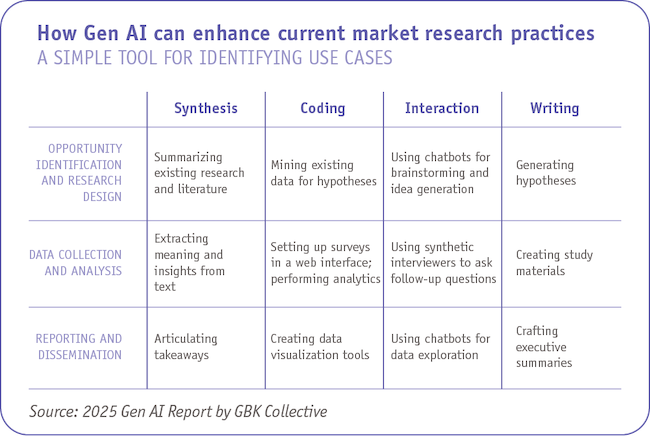AI-generated insights: A road map for research leaders
Editor’s note: Christine Odishoo is a senior vice president with GBK Collective, a marketing strategy, insights and analytics consultancy. Brian Smith, executive vice president, and Asad Tacy, senior analyst, GBK, also contributed to this article.
Gen AI is increasingly reshaping the way we approach market research – from streamlining traditional methods and accelerating data analysis to uncovering new insights and generating entirely new forms of consumer intelligence. What started as an experimental tool has now become a core part of research workflows for many researchers, helping organizations scale insights, enhance productivity and identify market opportunities faster than ever before.
Yet, the rapid adoption of AI also brings challenges. How do marketing leaders ensure the accuracy of AI-generated insights? How do we balance automation with human expertise? And how can we harness AI’s potential while mitigating security, governance and skill gap risks?
To explore these questions, GBK Collective recently partnered with academic experts –including Olivier Toubia, professor of business at Columbia Business School; Stefano Puntoni, professor of marketing at Wharton; and Eric Bradlow, GBK co-founder and vice dean of AI and Analytics at the Wharton School – to conduct a study [registration required] on how market researchers are integrating gen AI into their work.
Our survey of 170 research and insights professionals across the U.S. reveals a landscape filled with enthusiasm but tempered with some caution. The findings offer a road map for research leaders, helping them understand how AI is being used today and where it is headed next.
AI adoption in market research: A rapidly evolving landscape
More than half of respondents (56%) say their companies are ahead of the curve in gen AI adoption, with many embracing the technology at an experimental and collaborative level. While research teams are optimistic about gen AI’s potential, they remain cautious about its risks.
At the company level, adoption is being driven both top-down (by leadership) and bottom-up (by end users experimenting with AI tools). Despite the broad adoption, few companies have established clear governance policies – in fact, most firms have minimal restrictions on AI use, beyond requiring employees to log in with business accounts or use approved platforms like ChatGPT, Google Gemini or Microsoft Copilot.

At the individual level, researchers are highly engaged with AI:
- 84% believe gen AI will positively impact their work
- 84% say it will increase productivity and efficiency
- 82% agree that integrating gen AI is critical to staying competitive
Despite this optimism, concerns remain:
- 77% worry about making faulty business decisions due to AI-generated misinformation
- 75% are concerned about data security and privacy risks
- 71% fear that reliance on gen AI will create skill gaps over time
These findings highlight a dual reality: gen AI is both a powerful enabler and a potential risk – making it essential for companies to establish a structured approach to AI adoption.
Four core applications of gen AI in market research
While gen AI’s potential in research is vast, we have broken down the applications into four distinct areas: supporting current research practices, replacing current practices, filling gaps in market understanding and creating new types of data and insight.

1. Supporting current research practices
The most widespread application of gen AI in research is enhancing existing practices, making them faster, more cost-effective and easier to scale. Nearly half of respondents (45%) are using gen AI for this purpose today, with the following being the most common use cases among those who have used gen AI to support current practices:
- Document summarization (62%)
- Proposal writing or editing (59%)
- Document editing (59%)
- Data analyses (58%)
- Research discussion guide development (55%)
These wide-ranging applications show how AI is streamlining insights generation across various functional areas and task types.
“We are seeing generative AI speed the delivery of insights, allowing people to not spend so much time on data analyses or what I would call surface-level insights,” said Bradlow.
By automating manual research tasks, AI is freeing up professionals to focus on deeper insights and strategic initiatives rather than spending hours on data wrangling.
2. Replacing current practices
Gen AI is also being used to replace some current research approaches, particularly:
- Synthetic data generation (used by nearly 40% of respondents)
- Persona development (28% adoption, with 54% planning to use it in the future)
Synthetic data generation – where AI models generate realistic customer responses to replace or supplement real-world data collection – has the potential to revolutionize how researchers gather insights. However, many professionals remain uncertain about its reliability with only about a third saying that gen AI is “great” at this function.
“There are also some inherent differences and limitations when it comes to insight generation,” said Toubia. “While I use generative AI as a quick testing ground to be able to fine-tune language or summarize data, we are not yet at a point where it can replace humans.”
AI-generated consumer personas offer an exciting opportunity for brands to test new products or services without the risk of leaking proprietary information, but research teams must refine validation frameworks to ensure these synthetic insights align with real-world consumer behavior. Most respondents (58%) feel that gen AI performs are just “OK” at generating personas for the time being but remain optimistic about utilizing this in the future.
3. Filling gaps in market understanding
Beyond improving efficiency, gen AI is also opening new avenues for insight generation. Market researchers see AI’s greatest potential in:
- Competitive intelligence (used by 41% of respondents)
- Providing empirical evidence toward a data-driven decision (38%)
- Social media listening (35%)
By uncovering insights that are not available through conventional data, AI is becoming a critical tool for identifying market opportunities and shaping go-to-market strategies.
“The first wave of interest and use for generative AI centered more on the content generation side of things … using algorithms to generate content,” said Puntoni. “Now we are seeing AI become a prediction machine … we are now thinking about a lot of problems that can actually be framed as a prediction problem.”
As AI’s predictive capabilities evolve, research teams will increasingly rely on it to anticipate market trends and customer behaviors before they fully emerge in conventional data sets.
4. Creating new types of data and insight
The most forward-looking application of gen AI is its ability to generate entirely new data sets, offering insights that weren’t previously possible, including generating digital twins – virtual models of consumer segments that simulate behaviors, preferences and decision-making. Currently about one-third (37%) of respondents use this functionality but more than 40% plan to use it in the future.
While this remains the least adopted category currently, it represents one of the most promising areas for future innovation. However, this also raises concerns about ensuring AI-generated outputs remain accurate and free from bias.
“If you feed the wrong data to a large language model, it could just lead you down the wrong path entirely,” said Toubia.
Organizations will need to be vigilant in assessing the accuracy and reliability of AI-generated insights to prevent flawed data from influencing critical business decisions.
Balancing innovation with oversight: The path forward
While AI is clearly transforming market research, companies must approach adoption strategically. Our study highlights three key considerations for research leaders:
1. Invest in AI governance
Despite broad adoption, most firms lack clear AI policies. Organizations must establish clear policies around how sensitive data is managed and what safeguards are in place to prevent bias and misinformation. These policies should leave ample freedom for individual experimentation while minimizing risks.
2. Prioritize human oversight
Gen AI does not replace human judgment – it enhances it. Companies should focus on upskilling research teams so they can:
- Validate AI-generated insights before they inform critical business decisions
- Develop stronger prompt engineering skills to improve AI output
- Balance AI automation with research expertise
3. Test and learn with purpose
Companies should adopt a "test and learn" approach, experimenting with gen AI while constantly evaluating its impact on decision-making.
Another important success factor is firms taking both a top-down and bottom-up approach to experimentation with gen AI, with leaders setting the vision and strategy and employees being empowered to experiment and explore new ways to leverage AI for their individual roles.
Leaders should also ensure that AI capabilities are used to their fullest extent possible across individuals and teams, particularly in areas where it currently excels (e.g., writing/editing documents).
“The key to making good decisions with data is to think without data,” said Puntoni.
Balancing automation and human expertise
Gen AI is rapidly reshaping how market researchers collect, analyze and interpret data. As our study shows, it is accelerating traditional research methods, enabling new ways to generate insights and even creating entirely new types of data. Yet, its full potential will only be realized when organizations strike the right balance between automation and human expertise.
For market research leaders, success lies in building a clear AI strategy that prioritizes governance, accuracy and responsible experimentation. AI can enhance decision-making, but its value depends on data quality, validation processes and human oversight.
The firms that take a proactive, strategic approach – leveraging AI not just for efficiency, but to uncover deeper consumer insights and shape smarter business strategies – will be the ones that gain a lasting competitive edge.
